Looking for the ultimate trailbike? If you're of average height and weight, most of the bigger four-strokes can be too much to handle on technical trails and, to a lesser degree, the same can be said for the shrinking choices of off-road two-strokes. Is there an ideal bike outside mainstream cc?At around 5 feet 10 inches and 165 pounds each we, DR Art Director Joe McKimmy and Publisher Sean Finley, definitely fall into this category of average (unfortunately, this is true in more ways than just height and weight). With that in mind and two of the most uniquely sized displacements in off-road motorcycling at our sides, we set out to represent the average guy and find his new best bike.McKimmy grew up riding in the woods of Michigan and favors the light weight and simplicity of the KTM 200 while Finley is a Southern California desert rider (preferring the difficult-to-find "tight stuff") and was excited about the return of the 400 to KTM's XC-W line as an alternative to the big 450cc four-strokes (and the "too racy" 250 XCF-W). So, both of us will defend our bike choices to help you decide which one might be best for you.For our duel, we spent a day in the high desert of SoCal riding with Steve Hengeveld and event announcer/helmet painter Jerry Bernardo followed up by a race test at the final round of the 2008 AMA FMF National Enduro series near Wickenberg, Arizona. Our desert day allowed for some fun trail riding and bike swapping-to see what we were missing-and the enduro provided nearly five hours of challenging, technical terrain with a lot of diversity, the only consistent factor being a lot of rocks and a constant realization that neither of us are exactly in "National Enduro" shape. The new National Enduro format emphasizes speed in the test sections, yet the overall riding time and diversity provide plenty of time to determine if you chose a good bike or not.KTM 400 XC-W
The 400 Four-Stroke Is Best...
So why would a 400 be better than a 450? Jimmy explained this really well in our First Impression (November 2008) of the bike, and I cannot agree more. The 400 has a more manageable power delivery, and the shorter stroke somehow makes the bike feel lighter. Even though the little 200 is easy to kick over, it's not easier than pushing that magic button on the 400, especially when you have to do so several times throughout the day. The Wickenberg Enduro took place in 95-degree temperatures, and my desk job training regimen had me ready to heave and pass out at the final check. I'm pretty sure I wouldn't have been able kick over any bike at that point!As for performance, the 400 was incredible through all of the diverse conditions we threw at it. Joe argues that the 200 two-stroke is easier to flick around in the technical stuff, and I honestly thought he would crush me at the enduro. I was pretty stoked to find that I was hanging right with him in the first special test, and it appeared that while my four-stroke was planted to the trail and going through the chop, Joe was skipping around a little. I made my way past and put some time on him and figured we might as well go back to the truck since beating Joe seemed pretty easy.I took off more aggressively at the next test to be in front (why should I take off behind the slow guy?) but this time I couldn't shake the little two-stroke, so I let him go. While I could see that Moto Joe could maneuver his little bike pretty well in the tighter sections, I still felt I had an advantage in overall power and handling, especially in the sandy routes, but he did finish the section ahead of me. Maybe we weren't done yet.
We continued to trade "victories" over the next few tests and entered the final test equal on points and sitting in third (me and my 400) and fourth in our class. I felt the 400 four-stroke was proving to be an advantage on the technical climbs, but the 95-degree temps, challenging trail and nearly four hours of competition had us both ready to pass out. I'll let Joe brag about kicking my butt in the final test, but I still feel that the 400 is one of the best trailbikes available, for both competition and recreational trail riding. The mellow power delivery will actually allow you to cruise and tractor up obstacles, which was a welcome option on the five-mile-long waterfall climb that made up most of that last test. I consider Joe to be a much better trail rider/racer than I am, so the fact that I managed to beat him in any of the tests proves to me that the KTM 400 XC-W is the choice for me.Counterpoint: What Did Sean Like About The 200?
. The 200 two-stroke does feel smaller and as if it has a lower seat height, providing a little more confidence in the extremely technical sections.. For a two-stroke, the power delivery is amazing. It does not have the torque of the 400, but you can truly lug it more than you think you should be able to.KTM 200 XC-W
No, The 200 Two-Stroke Is Best...
After switching between the two bikes prior to Wickenberg, I have to say that the 400 XC-W does have a nice, even, controllable power and it feels lighter and more manageable than a 450. It's also a lot more stable in fast rough sections than the 200 XC-W, and I'll admit I was completely caught off-guard when I saw the 400 XC-W whiz by me in the first test section of the race. However, I still believe the 200 XC-W is a better bike for me.Sean failed to mention that he has been racing his entire life and that I have only beaten him in one race...ever. So when I saw him zip past I thought I was done for sure. Surprisingly, I was able to hang within a few seconds of him for most of the day. Maybe it was because he was confused on how the enduro scoring worked-after all, it was his first enduro-or maybe it was the fact he was out of racing shape. I don't think so; he ran a marathon last year, and I only run from cold water when I'm surfing. It was the lightweight 200 that kept me in the game.Even though Sean seemed to have the edge on handling in the fast, rough sections, I had the upper hand on the tight, gnarly, slow sections. The 200 two-stroke has great low-end to midrange chugging power that allows you to ride up and over difficult terrain. I quickly figured out that I could ride it much faster and smoother by keeping it in the meaty, chugging power. It proved to be a huge energy saver in the longest test section of the day.The biggest advantage the 200 XC-W has over the 400 for me is the weight difference. You wouldn't notice it that much when you're slicing through fast flowing sections. But when it comes to the tight stretches and you're running much lower speeds (like the last section of the enduro) and you're completely exhausted, you really feel it. If that's the advantage I need to beat an ex-pro quad racer/marathon runner, I'll take the 200 XC-W over the 400 XC-W any day.Counterpoint: What Did Joe Like About The 400?
. Smooth controllable power.
. Great handling through the fast, rough stuff.
. Electric start.
. You don't have to mix the gas.How do we really feel about these bikes? They're sitting in our garages right now, with custom RidePG.com graphics with our names printed on them. We have the choice to ride nearly any 2009 bike in the DR stable, and we've already grabbed these for the year and have no plans to put them back into the test rider rotation. We even loved them on the motocross track. Through this comparison, we each found our perfect bike.
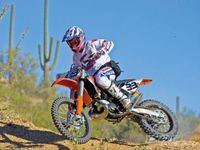
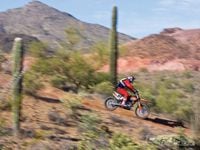
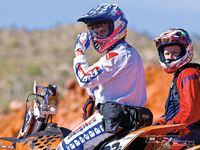

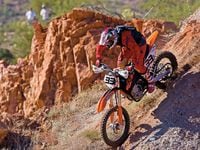


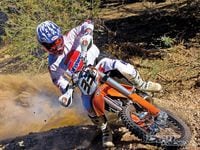
/cloudfront-us-east-1.images.arcpublishing.com/octane/4PLHXJPL5ZFTFN5F4RA3S7UZ6I.jpg)

/cloudfront-us-east-1.images.arcpublishing.com/octane/656MRIMBP5DYLN2WZHAE4HHBHU.jpg)
/cloudfront-us-east-1.images.arcpublishing.com/octane/V3VDJRGW2VF3BCU36I4CA7MHQE.jpg)
/cloudfront-us-east-1.images.arcpublishing.com/octane/EKDLFEU34ZEPTMZXIZHYTZNLV4.jpg)

/cloudfront-us-east-1.images.arcpublishing.com/octane/7EYEIMXIDRBXFJWVBTM7VX7V7Y.jpg)
/cloudfront-us-east-1.images.arcpublishing.com/octane/KIO2NYATINDRHHZ3AKZNOXLAIA.jpg)
/cloudfront-us-east-1.images.arcpublishing.com/octane/QGA7Q3Y2HFDL5ASU6YHK7JC324.jpg)
/cloudfront-us-east-1.images.arcpublishing.com/octane/7NGE6GYQX5D27FALYXOOLDXH3Y.jpg)
/cloudfront-us-east-1.images.arcpublishing.com/octane/6YMK7JSIZRCXJCOWWEP2ZYAJAM.jpg)
/cloudfront-us-east-1.images.arcpublishing.com/octane/ZK3MM4FYPBGHHIEYKZPY6TKNG4.jpg)
/cloudfront-us-east-1.images.arcpublishing.com/octane/M6Y46E477JH3FKTQ4BXDM4375U.jpg)
/cloudfront-us-east-1.images.arcpublishing.com/octane/34H7OS3XJJECJG6OJB7JIMYROE.jpg)

/cloudfront-us-east-1.images.arcpublishing.com/octane/NLAQFU2DJJCPLCTNHM5KVJCJSM.jpg)


/cloudfront-us-east-1.images.arcpublishing.com/octane/SPGKEWJNPBG3JO2BYCHXVF37QM.jpg)
/cloudfront-us-east-1.images.arcpublishing.com/octane/M2ZP7BKRFBCLRCNTGTKZSEFHUQ.jpg)
/cloudfront-us-east-1.images.arcpublishing.com/octane/NFA7O6WBWRFSRG3626H5YMEHT4.jpg)

/cloudfront-us-east-1.images.arcpublishing.com/octane/6PKJMRQWIJBKDAIUBWQUBXR45E.jpg)
/cloudfront-us-east-1.images.arcpublishing.com/octane/AX3ZOTLN5JHRPNVGM7BO2XIIEA.jpg)